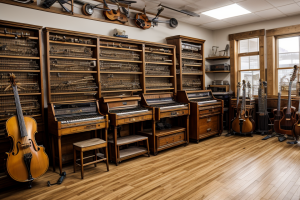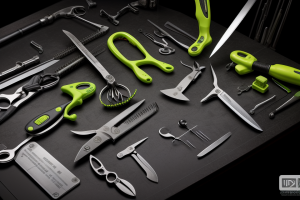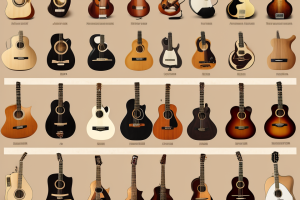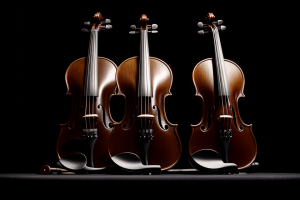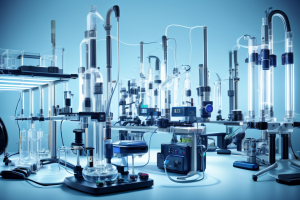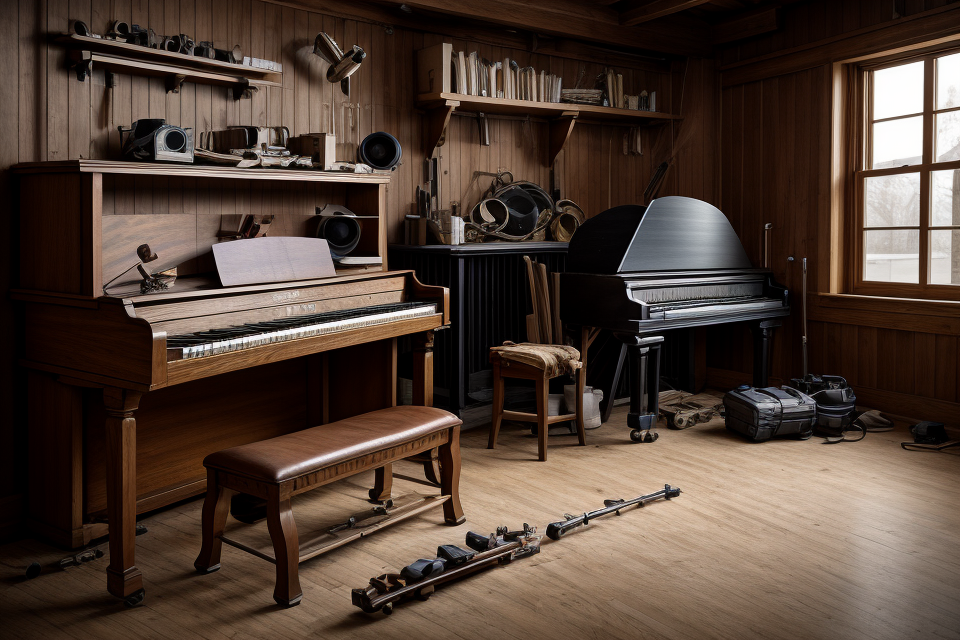
When it comes to musical instruments, regular maintenance is crucial to ensure they remain in top condition. Overhauling an instrument is a comprehensive process of disassembling, cleaning, inspecting, and reassembling it. This involves meticulous attention to detail, from the mechanisms to the wood or metal components, to restore the instrument to its optimal performance level. Overhauling can involve major repairs, restringing, regulation, and adjustments to the action, soundpost, and bridge. In this article, we will explore the intricacies of overhauling an instrument and what it entails for different types of instruments. Whether you’re a musician or a luthier, understanding the overhaul process is essential to keep your instrument playing its best.
To overhaul an instrument means to thoroughly inspect, clean, and repair it. This process is typically done on equipment or machinery that is subject to regular use or heavy wear and tear, such as an automobile engine or a musical instrument. The goal of an overhaul is to restore the instrument to its best possible condition and to extend its lifespan. This may involve replacing worn or damaged parts, cleaning and lubricating moving parts, and adjusting or replacing worn or damaged strings or other components. Overhauling an instrument can be a complex and time-consuming process, but it is essential to ensure that the instrument continues to function properly and to prevent breakdowns or damage that could compromise its performance.
What is an instrument overhaul?
Definition of an instrument overhaul
An instrument overhaul refers to the process of disassembling, cleaning, inspecting, and reassembling an instrument in order to restore it to its original condition and ensure its proper functioning. This process is typically carried out by trained technicians who specialize in the repair and maintenance of musical instruments.
During an instrument overhaul, every component of the instrument is carefully examined and any worn or damaged parts are replaced. This may include the tuning pins, keys, pads, corks, and other essential parts. The instrument is also thoroughly cleaned and polished to remove any dirt or debris that may have accumulated over time.
In addition to restoring the instrument’s physical condition, an overhaul may also involve adjusting the instrument’s mechanics to ensure optimal performance. This may include adjusting the action, regulating the humidity level, and fine-tuning the instrument’s sound quality.
Overall, an instrument overhaul is a comprehensive and meticulous process that requires a deep understanding of the instrument’s design and construction, as well as a commitment to restoring it to its optimal condition.
Importance of instrument overhaul
Instrument overhaul refers to the process of disassembling, cleaning, inspecting, and reassembling an instrument. This process is crucial for ensuring that the instrument is in optimal condition and functions correctly. The importance of instrument overhaul can be broken down into several key points:
- Maintenance of accuracy: Over time, instruments can become dirty or damaged, leading to inaccuracies in measurements. Overhauling the instrument ensures that it is free from dirt, debris, and other contaminants that can affect its accuracy.
- Increased lifespan: Regular overhauls can help extend the lifespan of an instrument by identifying and addressing any issues before they become more significant problems. This can save money in the long run by preventing costly repairs or replacements.
- Improved safety: In some cases, faulty instruments can pose a safety risk to users. Overhauling an instrument can identify any potential hazards and ensure that the instrument is safe to use.
- Compliance with regulations: Some industries have strict regulations regarding the use of instruments. Overhauling an instrument can help ensure that it meets these regulations and is in compliance with industry standards.
Overall, instrument overhaul is crucial for maintaining the accuracy, lifespan, and safety of an instrument. Regular overhauls can help prevent breakdowns and ensure that the instrument is functioning optimally.
Instruments that require overhaul
Instrument overhaul refers to the process of disassembling, cleaning, inspecting, and reassembling an instrument to ensure that it is in proper working condition. This process is crucial for maintaining the accuracy and reliability of the instrument. The following are some examples of instruments that typically require overhaul:
- Microscopes: Microscopes are used in scientific research, medicine, and industry for viewing and analyzing samples at a magnified scale. Over time, the optical components of microscopes can become dirty or worn, affecting the image quality and accuracy of the measurements. An overhaul involves cleaning and replacing the worn parts, adjusting the optical elements, and calibrating the microscope to ensure accurate measurements.
- Spectrometers: Spectrometers are used to measure the spectrum of light, which is essential in fields such as chemistry, physics, and biology. The optical components of spectrometers can become dirty or damaged, affecting the accuracy of the measurements. An overhaul involves cleaning and inspecting the optical components, calibrating the instrument, and verifying the accuracy of the measurements.
- Thermometers: Thermometers are used to measure temperature, which is critical in many fields such as medicine, food processing, and manufacturing. Over time, the mechanical components of thermometers can become worn or damaged, affecting the accuracy of the measurements. An overhaul involves disassembling the thermometer, cleaning and inspecting the mechanical components, and replacing any worn parts before reassembling and calibrating the instrument.
- Analytical balances: Analytical balances are used to measure the mass of samples with high precision, which is crucial in fields such as chemistry, biology, and pharmaceuticals. Over time, the mechanical components of analytical balances can become worn or damaged, affecting the accuracy of the measurements. An overhaul involves disassembling the balance, cleaning and inspecting the mechanical components, and replacing any worn parts before reassembling and calibrating the instrument.
Overall, an instrument overhaul is a crucial process in ensuring the accuracy and reliability of the instrument, and it is essential to follow the proper procedures to prevent damage to the instrument and ensure its longevity.
Types of overhaul services
When it comes to instrument overhaul services, there are several types of services that can be offered. These services are designed to restore an instrument to its optimal condition, ensuring that it is functioning properly and can be used for its intended purpose. Here are some of the most common types of overhaul services:
- Full overhaul: This is the most comprehensive type of overhaul service, and it involves a complete restoration of the instrument. This includes disassembling the instrument, cleaning and inspecting all of its components, and making any necessary repairs or replacements. Once the instrument has been fully overhauled, it will be reassembled and tested to ensure that it is functioning properly.
- Partial overhaul: This type of overhaul service is less comprehensive than a full overhaul, and it typically involves only specific components of the instrument. For example, a partial overhaul might involve cleaning and inspecting the keys, valves, or pads of a brass instrument.
- Adjustment and maintenance: This type of overhaul service is focused on maintaining the instrument’s current condition and ensuring that it continues to function properly. This might involve adjusting the instrument’s mechanisms, oiling its moving parts, or cleaning and polishing its exterior.
- Repair: While not necessarily an overhaul service, repair work can be an important part of maintaining an instrument. This might involve fixing broken keys, replacing worn-out pads, or repairing cracks in the instrument’s body.
The type of overhaul service that is right for an instrument will depend on its age, condition, and the needs of the player. In general, however, it is recommended that instruments be overhauled regularly to ensure that they are functioning properly and to prevent damage from occurring over time.
The process of instrument overhaul
Preparation for overhaul
Overhauling an instrument is a comprehensive process that requires meticulous planning and preparation. It involves a series of steps that must be carefully executed to ensure the successful restoration of the instrument to its optimal condition. The preparation phase is a critical aspect of the overhaul process, as it lays the foundation for the subsequent steps.
One of the first steps in the preparation phase is to carefully inspect the instrument to identify any defects or damages that may have occurred during use. This inspection involves a thorough examination of all the components of the instrument, including the mechanisms, keys, pads, and reeds. Any worn or damaged parts are identified and documented for repair or replacement during the overhaul process.
Another important aspect of the preparation phase is the disassembly of the instrument. This involves carefully removing all the components of the instrument, such as the keys, valves, and springs, to facilitate easy access to the various parts. This disassembly process is carried out with great care to avoid damage to any of the components.
Once the disassembly process is complete, the instrument is thoroughly cleaned and any rust or corrosion is removed. This is followed by a detailed inspection of all the components to identify any worn or damaged parts that require replacement. The instrument is then reassembled, with each component carefully fitted back into place.
In addition to the physical preparation of the instrument, the preparation phase also involves the selection of the appropriate tools and equipment that will be used during the overhaul process. This includes specialized tools for cleaning, polishing, and repairing the various components of the instrument. The selection of the right tools is critical to ensure that the overhaul process is carried out efficiently and effectively.
Overall, the preparation phase is a crucial aspect of the instrument overhaul process. It lays the foundation for the subsequent steps and ensures that the instrument is restored to its optimal condition. The careful inspection, disassembly, cleaning, and reassembly of the instrument, as well as the selection of the appropriate tools and equipment, are all critical to the success of the overhaul process.
Disassembly and cleaning
When it comes to overhauling an instrument, the first step is disassembly and cleaning. This process involves carefully taking apart the instrument and cleaning each component to remove any dirt, dust, or debris that may have accumulated over time. Here are some details of what is involved in this part of the overhaul process:
- Careful disassembly: The instrument is carefully taken apart, with each component being carefully removed and set aside. This is typically done by someone who is experienced with the specific type of instrument, as they will know exactly how to disassemble it without causing any damage.
- Cleaning each component: Once the instrument has been disassembled, each component is cleaned individually. This may involve using specialized cleaning solutions or tools to remove any dirt or debris that may have accumulated over time.
- Inspection of components: During the cleaning process, each component is also inspected to ensure that it is in good condition. Any components that are found to be damaged or worn will need to be repaired or replaced before the instrument can be reassembled.
- Drying and inspecting: After cleaning, each component is dried and inspected for any damage.
- Reassembly: Once all components have been cleaned, dried, and inspected, the instrument can be reassembled. This is typically done by someone who is experienced with the specific type of instrument, as they will know exactly how to reassemble it without causing any damage.
It is important to note that the disassembly and cleaning process should only be done by someone who is experienced with the specific type of instrument. This is because the process can be complex and requires a certain level of knowledge and skill to ensure that the instrument is not damaged during the process.
Inspection and evaluation
When it comes to overhauling an instrument, the first step is to conduct a thorough inspection and evaluation. This process involves a comprehensive examination of the instrument to identify any wear, damage, or other issues that may affect its performance. Here are some of the key components that are typically evaluated during an instrument inspection:
- Mechanical components: The mechanical components of an instrument, such as the keys, valves, and pads, are checked for wear and damage. Any issues that are identified may require repairs or replacement.
- Electrical components: The electrical components of an instrument, such as the pickups and wiring, are checked for proper function. Any issues that are identified may require repairs or replacement.
- Cosmetic condition: The overall cosmetic condition of the instrument is evaluated to determine if any repairs or refinishing are necessary.
- Functionality: The instrument is tested to ensure that it is functioning properly and meeting the specifications of the manufacturer.
In addition to these components, the inspection may also include a thorough cleaning and maintenance of the instrument to ensure that it is in optimal condition. This may involve removing dirt and debris, oiling moving parts, and adjusting mechanisms to ensure proper function.
Overall, the inspection and evaluation process is critical to the success of an instrument overhaul. By identifying any issues and addressing them early on, it is possible to ensure that the instrument is returned to optimal condition and ready to perform at its best.
Replacement of parts
When it comes to overhauling an instrument, one of the most critical aspects is the replacement of parts. This process involves identifying and replacing any worn-out or damaged components to ensure that the instrument is in good working condition. The following are some of the parts that may need to be replaced during an instrument overhaul:
- Pads: Pads are an essential component of many instruments, such as trumpets and trombones. Over time, these pads can become worn or damaged, causing issues with the instrument’s performance. When overhauling an instrument, the worn-out pads are typically replaced with new ones to restore the instrument’s functionality.
- Valves: Valves are a crucial part of brass instruments such as tubas and horns. They control the flow of air through the instrument and can become dirty or damaged over time. When overhauling an instrument, the valves are typically cleaned and replaced if necessary to ensure proper function.
- Springs: Springs are found in many instruments, including pianos and guitars. They are responsible for providing tension and maintaining the instrument’s proper tuning. Over time, springs can become worn or damaged, affecting the instrument’s performance. During an overhaul, these springs are typically replaced to restore the instrument’s tuning and performance.
- Strings: Strings are a vital part of stringed instruments such as violins and cellos. Over time, strings can become worn or damaged, affecting the instrument’s performance. When overhauling an instrument, the strings are typically replaced to restore the instrument’s tuning and performance.
- Cord: The cord is an essential part of a guitar, it is responsible for transmitting the vibrations of the strings to the body of the guitar. Over time, the cord can become worn or damaged, affecting the instrument’s performance. During an overhaul, the cord is typically replaced to restore the instrument’s performance.
It is important to note that the specific parts that need to be replaced will vary depending on the type of instrument being overhauled. However, by identifying and replacing any worn-out or damaged components, an instrument can be restored to its original condition and performance.
Reassembly and testing
When an instrument has been disassembled and its individual components have been thoroughly cleaned and inspected, the next step in the overhaul process is reassembly. This involves putting all of the parts back together and ensuring that they are properly aligned and functioning correctly.
One of the key challenges in the reassembly process is ensuring that all of the components are properly lubricated. This is because even the slightest amount of friction can cause an instrument to become out of tune or to function poorly. As such, the overhaul process typically involves the application of lubricants to various parts of the instrument, such as the keys, valves, and pistons.
Once the instrument has been reassembled, the next step is to test it to ensure that it is functioning properly. This typically involves playing a series of notes and listening for any changes in pitch or tone. It may also involve using specialized equipment, such as a tuner or a metronome, to help assess the instrument’s performance.
If any issues are identified during the testing process, the instrument may need to be disassembled again and the relevant components adjusted or replaced. However, if the instrument is deemed to be functioning properly, it is ready to be returned to the user.
Maintenance and care after overhaul
Overhauling an instrument involves a thorough cleaning, inspection, and repair of its various components to ensure optimal performance. After the overhaul, proper maintenance and care are crucial to prolong the instrument’s lifespan and maintain its quality of sound.
Some of the key steps in the maintenance and care process include:
- Regular cleaning: Regular cleaning helps to prevent the buildup of dirt, dust, and debris that can affect the instrument’s performance. Use a soft, dry cloth to wipe down the instrument after each use, and clean any moving parts with a soft brush.
- Lubrication: Lubricating the instrument’s moving parts can help to reduce friction and wear, ensuring smooth and effortless playing. Use a high-quality lubricant specifically designed for musical instruments.
- Humidification: Musical instruments, especially wood ones, can be affected by changes in humidity. Maintaining the correct humidity level can help to prevent cracks and other damage. Use a humidifier or hygrometer to monitor the humidity level and adjust as needed.
- Tuning: Regular tuning is essential to ensure that the instrument stays in tune and maintains its optimal performance. Check the tuning after each use and make adjustments as needed.
- Protection: Finally, protect the instrument from damage by storing it in a safe and secure location when not in use. Use a hard case or gig bag to protect the instrument from bumps and scratches, and avoid exposing it to extreme temperatures or humidity levels.
By following these simple steps, you can help to ensure that your instrument remains in top condition and provides you with many years of enjoyable playing.
Benefits of regular overhauls
Regular overhauls of instruments can bring numerous benefits. Here are some of the advantages of overhauling your instrument:
- Improved performance: Regular overhauls can help maintain the instrument’s performance at its peak. This is because overhauls involve a thorough inspection and cleaning of the instrument, which can help to identify and address any issues that may be affecting its performance.
- Increased lifespan: By regularly overhauling your instrument, you can help to extend its lifespan. Overhauls can help to identify and address any issues that may be affecting the instrument’s longevity, such as worn parts or damage to the body.
- Enhanced appearance: Overhauls can also help to improve the appearance of your instrument. This is because overhauls involve cleaning and polishing the instrument, which can help to remove any dirt or grime that may have accumulated over time.
- Increased value: By regularly overhauling your instrument, you can help to maintain its value. Overhauls can help to keep the instrument in good condition, which can help to preserve its value over time.
Overall, regular overhauls can help to ensure that your instrument is in top condition and performing at its best. Whether you’re a professional musician or a hobbyist, regular overhauls can help to extend the life of your instrument and keep it in good condition for years to come.
Cost of instrument overhaul
Overhauling an instrument can be a costly endeavor, depending on the complexity of the instrument and the extent of the overhaul needed. The cost of instrument overhaul can vary widely, ranging from a few hundred dollars for a simple overhaul of a brass instrument to several thousand dollars for a complete overhaul of a wooden instrument.
Factors that can affect the cost of instrument overhaul include:
- The type of instrument: Different types of instruments have different parts and mechanisms that may require different levels of expertise and time to repair or replace.
- The extent of the overhaul: A complete overhaul, which includes disassembling the instrument, cleaning and oiling all moving parts, and replacing any worn or damaged components, will typically be more expensive than a simple overhaul, which may only involve cleaning and oiling the instrument.
- The skill level of the technician: A technician with more experience and expertise may charge more for their services, but may also be able to complete the overhaul more efficiently and effectively.
- The location of the technician: If the technician needs to travel to the instrument overhaul location, this can add to the overall cost of the overhaul.
It is important to carefully consider the cost of instrument overhaul before deciding to proceed with the process. While overhauling an instrument can significantly improve its sound and performance, it may not be necessary for every instrument, and the cost may not be justified for certain instruments.
Common issues during instrument overhaul
Identifying common issues
When it comes to overhauling an instrument, it is important to identify common issues that may arise during the process. This is because identifying these issues early on can help prevent more serious problems from developing later on. Some common issues that may arise during an instrument overhaul include:
- Dirt and debris buildup: Over time, instruments can accumulate dirt and debris, which can affect their performance. This buildup can occur in places such as the keys, valves, and pads.
- Worn or damaged parts: Instruments are made up of many different parts, and over time, some of these parts may become worn or damaged. This can affect the instrument’s performance and may need to be repaired or replaced.
- Rust and corrosion: Instruments that are exposed to moisture or humidity may develop rust and corrosion, which can affect their performance. This is particularly common in brass and woodwind instruments, which are often made of metal and require regular maintenance to prevent rust and corrosion.
- Intonation issues: Intonation refers to the accuracy of an instrument’s pitch. Over time, intonation can become affected by worn or damaged parts, dirt and debris buildup, or other issues. This can cause the instrument to sound out of tune or produce notes that are not in the correct pitch.
By identifying these common issues early on, instrument technicians can take the necessary steps to repair or replace worn or damaged parts, clean the instrument, and adjust its intonation. This can help ensure that the instrument is functioning at its best and producing the best possible sound.
Addressing issues during overhaul
Overhauling an instrument involves a thorough inspection, cleaning, and repair of its various components. During this process, several common issues may arise that need to be addressed to ensure the instrument’s proper functioning. These issues can range from minor adjustments to major repairs, depending on the severity of the problem.
One common issue that arises during instrument overhaul is worn or damaged parts. These parts may include keys, valves, pads, or springs, which can affect the instrument’s performance. In such cases, the worn or damaged parts need to be replaced with new ones to restore the instrument’s functionality.
Another issue that may arise is the accumulation of dirt and debris, which can obstruct the instrument’s mechanisms and affect its sound quality. In such cases, the instrument needs to be thoroughly cleaned and disassembled to remove any dirt or debris that may be present. This may involve using specialized cleaning solutions or tools to ensure that all parts are thoroughly cleaned and free of any debris.
In some cases, the instrument’s mechanisms may require adjustment or repair to ensure proper functioning. This may involve adjusting the instrument’s tuning or regulation, which can affect its overall performance. In more severe cases, the instrument’s mechanisms may need to be completely overhauled or rebuilt to restore its functionality.
Addressing these issues during instrument overhaul is crucial to ensure that the instrument is functioning at its best. A professional technician with expertise in instrument repair and maintenance should be consulted to address any issues that arise during the overhaul process. By addressing these issues promptly and effectively, the instrument can be restored to its optimal performance, ensuring that it is ready to be used for years to come.
Preventing future issues
When overhauling an instrument, it is crucial to identify and address common issues that may arise. By doing so, it is possible to prevent future problems and ensure that the instrument continues to function optimally. Some of the common issues that may arise during an instrument overhaul include:
- Mechanical wear and tear: Over time, the mechanical components of an instrument may wear down, leading to decreased performance and potential damage. During an overhaul, these components should be inspected and replaced as necessary to restore the instrument to optimal performance.
- Corrosion: Instruments that are exposed to humid or salty environments may be prone to corrosion, which can cause damage to the instrument’s mechanisms and affect its overall performance. An overhaul should include cleaning and treating the instrument to prevent further corrosion.
- Dirt and debris: Instruments that are not regularly cleaned and maintained may accumulate dirt and debris, which can affect their performance and lead to damage over time. During an overhaul, the instrument should be thoroughly cleaned and any dirt or debris should be removed.
- Electronic malfunctions: Instruments that rely on electronic components may experience malfunctions over time, such as short circuits or faulty wiring. During an overhaul, these components should be inspected and replaced as necessary to ensure that the instrument functions properly.
To prevent future issues from arising, it is important to take proactive measures during the overhaul process. This may include:
- Regular maintenance: Instruments that are regularly maintained and cleaned are less likely to experience issues during an overhaul. It is important to establish a regular maintenance schedule and follow it to prevent future problems.
- Upgrades and replacements: Overhauling an instrument is an opportunity to upgrade or replace outdated or faulty components. By investing in upgrades or replacements, it is possible to improve the instrument’s performance and prevent future issues.
- Proper storage and handling: Instruments that are stored and handled properly are less likely to experience damage or wear and tear. It is important to follow best practices for storing and handling instruments to prevent future issues.
By taking these proactive measures, it is possible to prevent future issues and ensure that the instrument continues to function optimally for years to come.
Recap of key points
When an instrument is overhauled, it is disassembled, cleaned, inspected, and repaired as necessary. This process is essential to ensure that the instrument is in proper working order and to extend its lifespan. During an overhaul, several common issues may arise, including:
- Mechanical wear and tear: Over time, instruments can develop mechanical wear and tear, which can affect their performance. During an overhaul, any worn parts are repaired or replaced to restore the instrument’s proper function.
- Corrosion: Instruments that are exposed to moisture or humidity can develop corrosion, which can damage the instrument’s components. An overhaul involves cleaning and treating the instrument to remove any corrosion and prevent further damage.
- Dirt and debris: Instruments can accumulate dirt and debris over time, which can affect their performance. During an overhaul, the instrument is thoroughly cleaned to remove any dirt and debris and restore its proper function.
- Cosmetic damage: Instruments can also suffer cosmetic damage, such as scratches or dents. While cosmetic damage does not affect the instrument’s performance, it can still be repaired during an overhaul to restore the instrument’s appearance.
By addressing these common issues during an overhaul, instruments can be restored to their proper working order and extended their lifespan.
Importance of instrument maintenance
Instrument maintenance is a crucial aspect of ensuring that an instrument continues to function properly and provide accurate measurements. Regular maintenance helps to prevent damage to the instrument, extend its lifespan, and reduce the need for costly repairs or replacements. Here are some of the key reasons why instrument maintenance is so important:
- Prevents damage: Regular maintenance can help prevent damage to the instrument that could result from normal wear and tear, environmental factors, or other sources of stress. For example, regular cleaning and lubrication can help prevent corrosion and other forms of damage that could affect the instrument’s accuracy or lifespan.
- Extends lifespan: Proper maintenance can help extend the lifespan of an instrument by reducing the need for repairs or replacements. Regular cleaning, calibration, and other forms of maintenance can help prevent problems that could otherwise lead to costly repairs or replacements down the line.
- Maintains accuracy: Instruments that are not properly maintained can become less accurate over time, which can lead to errors in measurements and data. Regular calibration and other forms of maintenance can help ensure that an instrument continues to provide accurate measurements, which is essential for many scientific and industrial applications.
- Saves money: While the cost of instrument maintenance may seem significant at first glance, it is often much less expensive than the cost of repairs or replacements down the line. By investing in regular maintenance, scientists and engineers can help ensure that their instruments continue to function properly and provide accurate measurements, which can save money in the long run.
Overall, instrument maintenance is an essential aspect of ensuring that instruments continue to function properly and provide accurate measurements. By investing in regular maintenance, scientists and engineers can help prevent damage, extend the lifespan of their instruments, maintain accuracy, and save money in the long run.
Final thoughts on instrument overhaul
After conducting a thorough examination of the various aspects of instrument overhaul, it is evident that this process is crucial for ensuring the longevity and optimal performance of an instrument. Instrument overhaul involves a comprehensive assessment of the instrument’s mechanical, electrical, and optical components, as well as the identification and resolution of any issues that may arise.
It is important to note that instrument overhaul is not a one-time event but rather an ongoing process that requires regular maintenance and upkeep. The frequency of instrument overhaul may vary depending on the type of instrument, its usage, and the environment in which it is operated.
Moreover, it is crucial to involve trained professionals in the instrument overhaul process to ensure that the instrument is handled and repaired by individuals with the necessary expertise. These professionals can conduct a thorough inspection of the instrument, identify any issues, and recommend appropriate solutions.
In conclusion, instrument overhaul is a critical process that should not be overlooked. Regular maintenance and upkeep, along with the involvement of trained professionals, can help extend the lifespan of an instrument and ensure its optimal performance. By prioritizing instrument overhaul, researchers and scientists can avoid potential issues and achieve accurate and reliable results.
FAQs
1. What is an instrument overhaul?
An instrument overhaul is a comprehensive process of restoring an instrument to its original specifications and ensuring that it is in optimal working condition. This process involves disassembling the instrument, cleaning and inspecting all its components, replacing any worn or damaged parts, and reassembling it with new lubricants and adjustments.
2. Why is an instrument overhaul necessary?
An instrument overhaul is necessary to ensure that the instrument is functioning properly and providing accurate readings. Over time, instruments can become dirty, worn, or damaged, which can affect their performance. Regular maintenance and overhauls can help prevent breakdowns, extend the lifespan of the instrument, and improve its accuracy.
3. What instruments can be overhauled?
Most types of instruments can be overhauled, including mechanical, electronic, and hydraulic instruments. Examples of instruments that may require overhauls include thermometers, pressure gauges, flow meters, and control valves.
4. How often should an instrument be overhauled?
The frequency of instrument overhauls depends on the type of instrument, its intended use, and the environment in which it is used. As a general rule, instruments that are used frequently or in harsh environments should be overhauled more often. It is recommended to consult the manufacturer’s guidelines or a qualified technician to determine the appropriate schedule for instrument overhauls.
5. What is involved in an instrument overhaul?
An instrument overhaul typically involves the following steps: disassembling the instrument, cleaning and inspecting all components, replacing any worn or damaged parts, reassembling the instrument with new lubricants and adjustments, and calibrating the instrument to ensure it is functioning properly. The specific steps involved may vary depending on the type of instrument and its intended use.
6. How long does an instrument overhaul take?
The time required for an instrument overhaul can vary depending on the type of instrument and the extent of the work required. Generally, an instrument overhaul can take several hours to several days to complete, depending on the complexity of the instrument and the availability of parts.
7. How much does an instrument overhaul cost?
The cost of an instrument overhaul can vary depending on several factors, including the type of instrument, the extent of the work required, and the location of the service provider. It is recommended to obtain quotes from multiple service providers to get an idea of the cost of an instrument overhaul.
8. Can I perform an instrument overhaul myself?
Some instruments can be overhauled by trained individuals with the necessary tools and equipment. However, it is recommended to consult the manufacturer’s guidelines and seek the advice of a qualified technician before attempting an instrument overhaul. Improperly performed overhauls can result in damage to the instrument or compromise its accuracy, which can have serious consequences in some applications.
